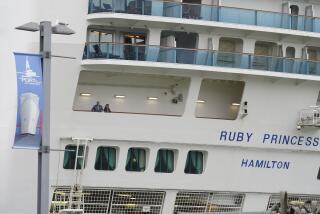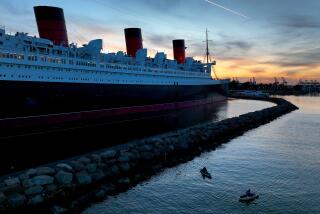Medical Costs Afloat
- Share via
Cruise-bound travelers budget for incidentals such as shipboard gambling and port side shopping, but few plan ahead for possible medical costs.
Of course no one expects to spend time in the ship’s infirmary, but inevitably, on every cruise, some do.
“We see an average of 20 people a day on our line,” roughly half crew members, half passengers, said Dr. Carter Hill, medical director of Holland America cruise line and clinical associate professor of medicine at the University of Washington, Seattle.
Most problems are minor and modestly priced. Sunburn, motion sickness, gastrointestinal upset, ear problems and colds are common, said Jennifer de la Cruz, spokeswoman for Carnival Cruise Line. Costs for these conditions are comparable--in some cases even lower--than medical costs at home, according to cruise line officials, and insurance sometimes covers charges.
But when more serious illnesses occur, costs can skyrocket. A $20,000-bill for an emergency airlift from the ship to the nearest port is not unusual, according to Gary Tice of International SOS Assistance, a company that contracts with firms to offer such services. He’s seen bills as high as $50,000 for an airlift using helicopter and jet.
Since the standard policy for health care requires payment when service is rendered, regardless of insurance coverage or the type of service needed, it can be beneficial to know before sailing just what the going rate is for medical attention at sea. Here’s a roundup, based on an informal poll of Holland America, Princess, Crystal Cruises, Carnival Cruise Line and Norwegian Cruise Line.
Visits to the infirmary cost from $20 to $50, with some ships charging more during off hours. On Crystal Cruises, for example, a daytime visit to the infirmary costs $38, but the after-hours cost is $50. Cabin visits are higher than infirmary appointments, usually $30 to $75.
Some medications are free. “Most lines provide anti-nausea medicine, acetaminophen or aspirin,” Hill said. Other over-the-counter medications cost roughly the same as in a drugstore, spokespersons said. Charges for prescription drugs run the gamut from pennies to, perhaps, $9 a pill.
X-rays cost from $20 to $80, depending on the body part being examined. Electrocardiograms cost $40 or $45; urinalysis from $5 to $30.
If medical care is needed as the result of an accident on the ship--a passenger fall on a just-swabbed deck, for example--the cruise line usually picks up the treatment tab. And typically, Hill said, the medical department on a cruise ship does not turn a profit and sometimes posts a loss.
Medical care afloat is getting better, contend Hill and others involved in upgrading maritime medicine. As one sign, early last year, Holland America began to stock thrombolytic agents that can be administered after a heart attack.
But even on the most luxurious ship with the best medical team, some tasks are not feasible. “You can’t routinely transfuse blood on a ship because there are no typing or cross-matching facilities,” Hill said, referring to the need to double check the blood type of the recipient before a transfusion.
This underscores a point that Hill wishes passengers would take seriously: “It’s important to think of these as medical departments or infirmaries,” rather than hospitals with sophisticated equipment. “They are not hospitals, but places where people are assessed” and the seriousness of their condition evaluated, Hill said.
If a passenger’s condition becomes serious, the ship doctor and other health care personnel must decide the best course: to take the passenger off the ship at the next port and transfer him or her to a hospital or to airlift that passenger to another medical center.
The risk of emergency evacuation and death while on board is real but not common, Hill said.
More than 377,000 passengers sailed on Holland America ships in 1994, Hill said. Fifteen died on board; 363 were disembarked on an emergency basis. One in 15 passengers who disembark in an emergency need an airlift, he said. In part because of improved medical facilities, the need for airlifting has been cut in half since 1992, according to Hill.
About a third of passengers who embarked in an emergency had heart-related problems. Others had respiratory problems, gastrointestinal bleeding and other GI problems, strokes, fractures, infectious diseases, endocrine and genitourinary problems.
The Healthy Traveler appears the second and fourth week of every month.
More to Read
Sign up for The Wild
We’ll help you find the best places to hike, bike and run, as well as the perfect silent spots for meditation and yoga.
You may occasionally receive promotional content from the Los Angeles Times.






